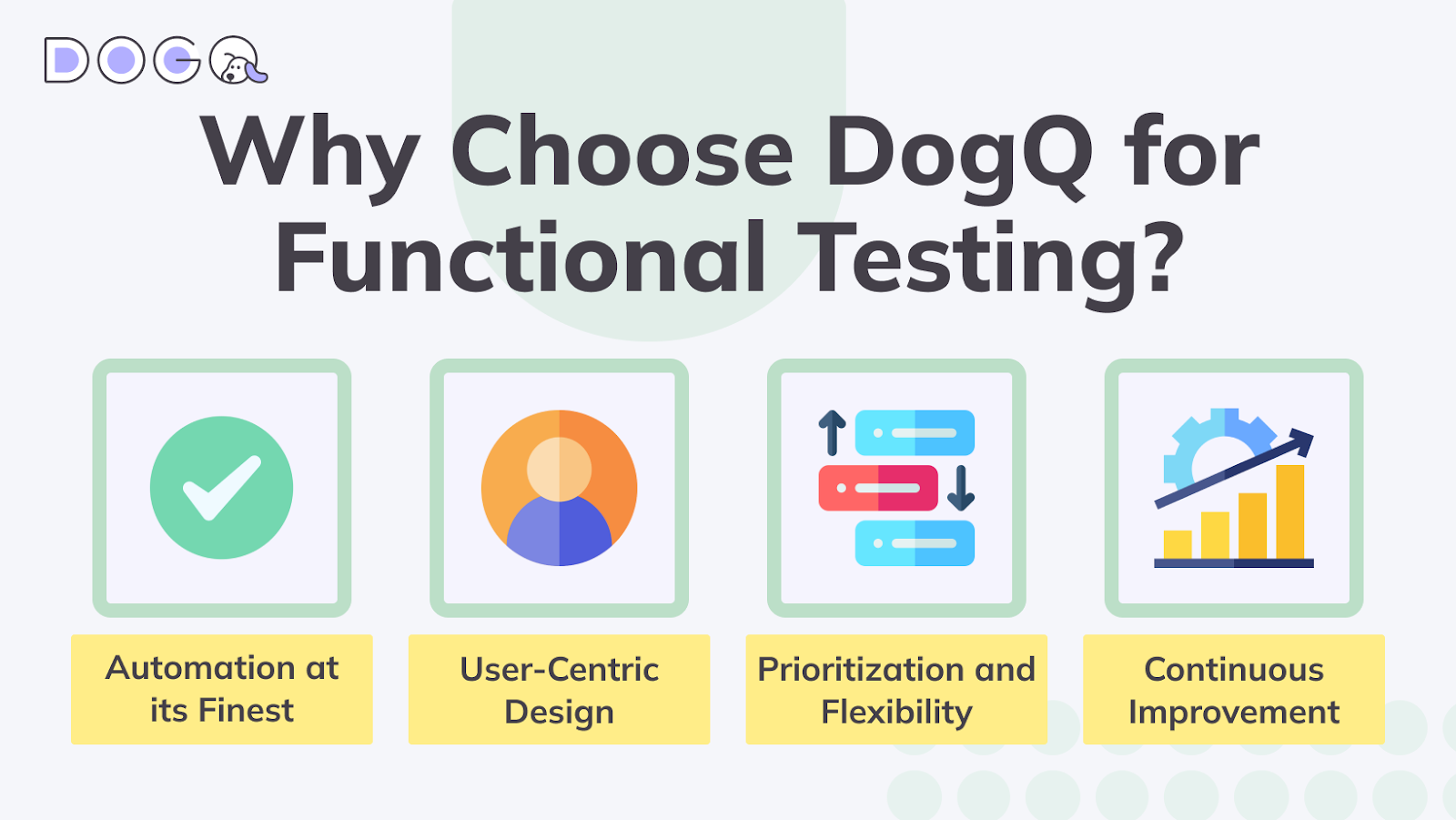Functional Testing Guide by DogQ
In our ultimate guide on functional testing discover the functional testing types, its core steps, best practices, and also pieces of advice by DogQ specialists.
How to ensure that your application not only meets the desired specifications but also delivers a seamless user experience? This is where functional testing steps into the spotlight, acting as the linchpin in assessing the operational integrity of software systems.
This guide is designed to be your compass in navigating through the complexities of functional testing. From the foundational principles to the nuanced strategies that guarantee thorough coverage, this guide aims to equip you with the knowledge and tools necessary to conduct this type of testing with confidence and precision. Here we go!
Table of contents
- What Is Functional Testing?
- Functional vs. Non-Functional Testing: Top 5 Differences
- Types of Functional Testing
- Steps of Functional Testing
- Functional Testing Best Practices by DogQ
- DogQ – Your Ideal Automated Tool for Functional Testing
What Is Functional Testing?
It’s about verifying that each function of the software application operates in conformance with the desired output. This type of testing scrutinizes user commands, data manipulation, searches, user screens, and integrations, ensuring that the application behaves as expected under various scenarios.
Thus, it covers a broad spectrum of testing activities, including but not limited to, unit testing, integration testing, system testing, and acceptance testing. Each of these activities targets different components and areas of the application, from individual functions and modules to the entire application in the context of the system or user environment.
In other words, functional testing is quintessential for identifying any discrepancies early in the development cycle, thereby enabling teams to make necessary corrections before the software reaches the end users.
A Functional Testing Example by DogQ
To bring the concept of functional testing to life, let’s consider a common feature found in many applications: a user registration process. This example will demonstrate how functional testing is applied to ensure that the registration feature operates as intended, aligning with the specified requirements.
Scenario: User Registration Process
Objective: To verify that the user can successfully register through the application’s registration form.
Test Steps:
- Navigate to the registration page: The first step involves accessing the application and navigating to the registration page, intended to allow new users to create an account;
- Input registration details: The tester inputs valid registration details into the form. This includes information such as the user’s name, email address, password, and any other required fields designated by the application;
- Submit the registration form: Upon filling out the form with the necessary details, the tester submits the form by clicking on the “Register” or “Sign Up” button;
- Verify account creation: Post submission, the application processes the input data. The tester then verifies that the account has been successfully created. This verification could be done through a confirmation message displayed on the screen, an email confirmation sent to the registered email address, or by attempting to log in with the newly created credentials;
- Check for data persistence: Lastly, the tester logs out and then attempts to log back in with the newly registered credentials to ensure that the user account persists and functions correctly within the system.
Expected Results:
- The application should navigate to the registration page without issues.
- The registration form accepts and processes the input details correctly.
- Upon submission, the application provides a clear indication (e.g., confirmation message or email) that the account has been successfully created.
- The user should be able to log in with the newly created account, verifying that the account is active and the data is stored correctly in the application’s database.
Outcome: If all the steps outlined above are executed without any discrepancies and the expected results are achieved, the user registration feature is considered to function correctly, passing the testing criteria.
Functional vs. Non-Functional Testing: Top 5 Differences
Now, let’s define how functional testing differs from non-functional testing. While both are integral to the quality assurance process, they focus on different aspects of the software system. In the table below, we’ve collected the top five differences that set them apart:
Types of Functional Testing
Functional testing encompasses a range of methodologies designed to verify that each aspect of a software application behaves as expected. Below, we explore its core type, each serving a unique purpose in the software development lifecycle.
Regression Testing
This type of testing ensures that new code changes have not adversely affected existing functionality. Regression testing is critical for maintaining software integrity over multiple development cycles, ensuring that updates or bug fixes don’t introduce new errors.
Unit Testing
The most granular level of functional testing, unit testing involves verifying the smallest testable parts of an application, typically individual functions or methods, to ensure they perform correctly in isolation.
➡️ Realted article: Unit Testing vs Regression Testing: Key Differences
Smoke Testing
Often referred to as “build verification testing”, smoke testing is a preliminary test that checks whether the major functions of a software application operate without crashing, ensuring the stability of a build before more rigorous testing is conducted.
Sanity Testing
A subset of regression testing, sanity testing is a quick, surface-level test conducted to verify that a particular function or bug fix works as intended. It’s performed after receiving a new build to decide if the build is stable enough for further testing.
System Testing
This testing evaluates the complete and fully integrated software product to ensure it meets the specified requirements. System testing considers the system’s overall functionality and performance, as well as its behavior under various conditions.
UI/UX Testing
It focuses on the software’s user interface and user experience, ensuring that the application is intuitive, user-friendly, and aesthetically pleasing. This type of testing assesses layout, design, and navigability, crucial for user satisfaction.
Integration Testing
Integration testing examines the interfaces and interactions between integrated components or systems. It identifies issues in the cooperation between integrated units, ensuring that combined parts work together as intended.
UAT (User Acceptance Testing) Testing
The final phase in functional testing, UAT testing involves real users testing the software in a production-like environment to validate that it can handle required tasks in real-world scenarios, according to the specifications.
Steps of Functional Testing
Functional testing is a systematic process aimed at verifying that every function of a software application operates in line with the specified requirements. The following core steps outline a structured approach to this kind of testing, ensuring comprehensive coverage and high-quality outcomes:
1. Identify the Testing Goals
The initial step involves understanding what the application is supposed to do from a functional perspective. This includes defining the objectives of the testing process, such as verifying specific features, functionalities, or bug fixes.
2. Create Test Scenarios
Based on the testing goals, develop a set of test scenarios that cover all the functional aspects of the application. These scenarios should outline the conditions under which each function will be tested to ensure completeness.
3. Prepare Test Data and Determine the Correct Outputs
For each test scenario, prepare the necessary input data and determine the expected outcomes. This preparation is crucial for validating whether the application behaves as intended under various conditions.
4. Run Test Cases and Validate the Result Against Specifications
Execute the test cases by providing the prepared input data and then compare the actual results with the expected outcomes. This step verifies the application’s functionality against the predefined specifications.

Functional Testing Best Practices by DogQ
Finally, to maximize the efficiency and effectiveness of the testing process, we consider following the best practices enumerated below:
Create Test Cases Early
Begin developing test cases as soon as the requirements are defined. Early preparation allows for identifying potential issues in the specifications before the development process advances too far.
Automate
Wherever possible, automate the execution of test cases. Automated testing not only speeds up the whole process but also increases its reliability by eliminating the potential for human error in repetitive tasks, compared to manual testing.
Understand the User’s Thought Process
Adopt the end user’s perspective when creating test cases. Understanding how users are likely to interact with the application can help identify critical areas of focus for testing.
Prioritize
Given the constraints on time and resources, prioritize test cases based on factors such as the criticality of features, the complexity of functions, and the risk of failure. This approach ensures that the most important areas are thoroughly tested.
DogQ – Your Ideal Automated Tool for Functional Testing
In the intricate world of software development, functional testing stands as a critical phase, ensuring that applications not only meet their design specifications but also deliver a seamless and intuitive experience to the end-user. Through the chapters of this guide, we’ve navigated the what, why, and how of this kind of testing, outlining its importance, types, core steps, and best practices.
The journey underscores a pivotal truth: while functional testing is indispensable, its complexity and scope demand a robust, efficient solution.
DogQ emerges as your ideal partner in automated testing, offering a platform that simplifies and accelerates the testing process. With its intuitive interface, comprehensive testing capabilities, and advanced automation features, DogQ stands out among other testing tools, as it’s engineered to address the challenges of testing head-on.
Why Choose DogQ?
- Automation at its Finest: DogQ’s automation capabilities allow you to streamline your testing process, from test case creation to execution and validation, reducing manual effort and increasing efficiency.
- User-Centric Design: Understanding the user’s thought process is key to effective functional testing. DogQ’s platform is designed with this in mind, enabling testers to simulate real user interactions and scenarios accurately.
- Prioritization and Flexibility: With DogQ, prioritizing critical test scenarios becomes effortless, ensuring that the most impactful tests are conducted first. Its flexible framework adapts to your project’s specific needs, regardless of size or complexity.
- Continuous Improvement: DogQ supports the creation of test cases early in the development cycle and facilitates iterative testing, ensuring continuous improvement and alignment with user expectations.

Functional testing is a journey of ensuring software excellence, and DogQ is the companion you need to navigate this journey successfully. Whether you’re tackling regression testing, system testing, UI/UX testing, or any other testing type, DogQ equips you with the tools you need to execute tests with precision and confidence.
So, don’t hesitate to contact us and try DogQ right now to unleash the full potential of testing and set new standards of software excellence. Let’s make testing available for everyone!
Latest Posts:
Sanity Testing Checklist by DogQ. Enhance the effectiveness of your sanity testing strategy and end-user satisfaction.
How to Write Test Cases: a Guide by DogQ. Explore our guide, covering everything from basics and types to common pitfalls and best practices.
UAT vs. Usability Testing: Demystifying Testing Types. Explore the distinct roles of user acceptance and usability testing types.
Related Posts:
How to Choose the Functional Testing Tool for Your Project. We have the list of automation testing tools for all kinds of projects.
Functional vs. Non-Functional Testing: Key Differences and Requirements. What is the difference between functional testing and non-functional testing?
UI, UX and Usability Testing: Everything You Need to Know. The concept of shift-left testing and how it can improve the quality of your product.
